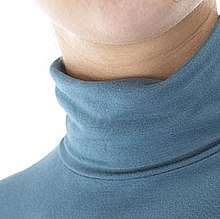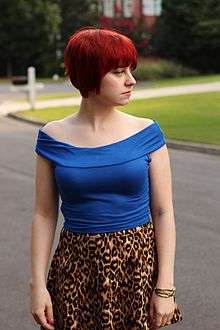Neckline
The neckline is the top edge of a garment that surrounds the neck, especially from the front view. Neckline also refers to the overall line between all the layers of clothing and the neck and shoulders of a person, ignoring the unseen undergarments.[1]
For each garment worn above the waist, the neckline is primarily a style line and may be a boundary for further shaping of the upper edge of a garment with, for example, a collar, cowl, darts or pleats. In that respect it is similar to the waistline and hemline.
List of neckline types
Necklines can be grouped into categories according to their shape and where they cut across the body:
- polo neck (circular)
- these are high close-fitting collars that wrap around the neck itself, and are also called turtlenecks. They are most common for sweaters (also called jumpers) or jerseys.
- jewel neckline (circular)
- these are round and sit at the base of the throat, and are also called the T-shirt neckline or crew neck.
- scoop neck (curved, concave up)
- these have a curved U-shape, with the arms of the U hanging on the shoulders. The depth of the U can vary, ranging from demure styles to plunging.
- V-neck (2–4 linear edges, side edges diverge)
- originate from the middle east, these are formed by two diagonal lines from the shoulders that meet on the chest creating a V shape. The depth of the V can vary, ranging from demure styles to plunging. The V may also be truncated by a small bottom edge, forming a trapezoid.
- surplice neckline
- these are similar to how a bathrobe's neckline is formed by one side of the garment overlapping the other. For a dress, the lower layer is usually sewn to the top layer just under the bust.
- portrait neckline
- a portrait neckline is a v-neck with the edges of the v placed out at the points of the shoulders rather than closer to the neck; it can be combined with a surplice neckline. [2]
- square neck (linear side edges neither converge nor diverge)
- these are characterized by three linear edges, the bottom edge meeting the side edges at right angles. The bottom edge cuts across the figure horizontally and the side edges pass over the shoulders. A special case of this is the slot neckline, in which the side edges are very close (roughly the width of the collar-bone points), forming a narrow slot.
- deep or plunging neck
- these are low necklines, in either V, U or square shapes, that reveal various amounts of cleavage, and some even extending to the natural waist line.
- boat neck (one edge, nearly linear)
- these have a high, wide, slightly curved neckline that pass past the collarbones and hang on both shoulders, and are also called bateau necklines or Sabrina necklines. A variation is the portrait neckline.
- off-the-shoulder (one edge, nearly linear. Also known as Carmen neckline)
- these are similar to boat necklines but are significantly lower, below the shoulders and collar bone. Usually these pass over the arms but, in the strapless neckline style, may pass under the arms. These necklines accentuate the shoulders and neck of the wearer.
- one-shoulder necklines (one edge, nearly linear)
- these are asymmetrical linear necklines that cut across the torso diagonally, usually from one shoulder to under the other arm.
- halter necklines (linear, side edges converge on neck)
- these feature a V-neck or scoop front neckline with straps which wrap around and connect at the nape of the neck.
- sweetheart necklines (side edges linear, curved bottom edge concave down)
- these have a curved bottom edge that is concave down and usually doubly scalloped to resemble the top half of a heart. The side edges often converge on the neck, similar to halter necklines. Sweetheart necklines accentuate the bosom.
- keyhole necklines
- these are similar to halter necklines, but the converging diagonal lines meet in front of the neck, forming a "keyhole". More generally, these feature a central hole, usually just below the collar bones. These necklines are seen infrequently.
 A folded turtleneck
A folded turtleneck T-shirt neckline
T-shirt neckline Men and women of the Royal Australian Navy in uniform V-necked shirts
Men and women of the Royal Australian Navy in uniform V-necked shirts- Deep V neckline
 A halter top
A halter top A woman in a tube top
A woman in a tube top T J Hart in a plunging neckline dress
T J Hart in a plunging neckline dress
Modifications of necklines
The shape of a necklines can be modified in many ways, e.g., by adding a collar or scarf, overlaying it with a gauzy material or decorating the edges with scallops, picots or ruffles. The neckline can be a sharp edge of fabric or a more gentle cowl, and can also be accentuated by pattern(s) in the fabric itself.
Ruffs were popular in the Elizabethan era.
Trends
Off-the-shoulders

The off-the-shoulder trend dates back to the Regency and Victorian Era. They were the height of fashion in the early to mid-nineteenth century. Charles Frederick Worth, the father of haute couture, designed many elaborate dresses, many of which featured bodices with off-the-shoulder sleeves and were very popular with prominent figures like Empress Eugenie.[3] Then in 1960s, French actress Brigitte Bardot put her own twist on this style, wearing off-the-shoulder tops with everything from midi skirts to pants, reviving the style. The style icon made off-the-shoulder sexy and trendy again and off-the-shoulder style also became known as the “Bardot” style.
Since resurfacing in 2014, off-the-shoulder trend has gained massive popularity. This look gives a sexy appeal without being too overt and looks good on a variety of body types; thus its popularity with consumers today.
See also
References
- ↑ "Definition of neckline". Retrieved 2016-09-02.
- ↑ "Wedding Encyclopedia: Neckline". Retrieved 2018-07-27.
- ↑ "A brief history of the off-the-shoulder trend". fashionmagazine.com.
External links
| Look up neckline in Wiktionary, the free dictionary. |
![]()